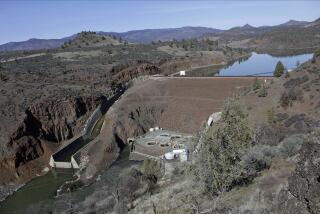Structural Integrity
- Share via
Transforming the boxes and bookshelves of research that inform a TV project into a book is no easy business, but the producers of “Great Projects” did well by enlisting James Tobin.
Winner of the National Book Critics Circle Award for his first book, “Ernie Pyle’s War,” and an accomplished biographer, Tobin wisely realizes that the great projects of America--from building of the dams to the creation of the Internet--are not impersonal but human stories that illuminate the genius and even heroism of engineers.
The stories of the individuals behind these projects make this well-written, attractively designed companion book to the upcoming PBS series such a success.
Mark Twain once said of the Mississippi: “[T]en thousand River Commissions ... cannot tame that lawless stream ... cannot say to it, ‘Go here,’ or ‘Go there,’ and make it obey,” but win or lose, the engineers of America made a go of it. It is their epic struggle that forms the first part of this four-part story.
To ensure safe navigation in the 1820s, engineers had to clear about 50,000 snags of uprooted trees; in later years, they had to construct levees along miles of riverbank, as well as canals, gates, channels and spillways, yet time and time again, the river would win over their herculean efforts.
Like the Mississippi, the Colorado River presented its own challenges, especially for Charles Rockwood, who diverted the Colorado into a desert-like California basin to form the Imperial Valley in 1905, when the waters made the valley bloom and put money into many pockets. Rockwood, however, ignored warning signs that silt buildup would clog his canal as spring-swollen crests came rushing downstream, filling the Imperial Valley like a washbasin. It took 30 years for the solution to that problem to be built in the form of the Hoover Dam.
The next section, “Power,” begins with the tale of Thomas A. Edison and the invention of the electric lightbulb, followed by his efforts to electrify a section of lower Manhattan. Edison’s trial-and-error experiences lighting New York City move easily to the efforts of his former secretary, Samuel Insull, who networked Chicago and ended up supplying current to 32 states. After the 1929 market crash, Insull’s overextended companies nearly went bust, ambitious politicians pilloried him and he was indicted and tried on securities fraud. He was justly found innocent. Part 3, “Metropolis,” deals with urban drinking water. Tobin tells how New Yorkers fought off persistent cholera epidemics in the 1830s by conveying pure drinking water more than 30 miles from the upstate Croton River through an ingenious series of tunnels, aqueducts and reservoirs. He also reconstructs the history of the breathtakingly beautiful George Washington Bridge over the Hudson from New Jersey to Manhattan.
The last part, “Pathways,” is seemingly the most arbitrary. It points out an analogy between the creation of the highway, bridge and tunnel network in Boston and the development of the Internet. It may seem a stretch, but any computer engineer I know would light up at the prospect of likening “the big dig” in Boston to the baffling-to-the-layperson properties of the Internet.
Any reader will hearken to the efforts of Tobin, whose smooth synthesis of historical detail, documentary transcripts and primary sources make this book worthy of its companion show.
*
David Haward Bain is the author of “Empire Express: Building the First Transcontinental Railroad.” He teaches at Middlebury College in Vermont.
More to Read
Sign up for our Book Club newsletter
Get the latest news, events and more from the Los Angeles Times Book Club, and help us get L.A. reading and talking.
You may occasionally receive promotional content from the Los Angeles Times.










